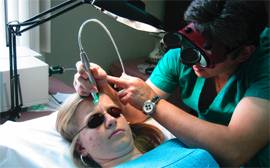Yachroma-Med application for dermatology and aesthetic surgery.
Laser methods in medicine have been used for about twenty years. The progress achieved by physicians and engineers from the first attempts
at using lasers in medicine in the 1970s and from the beginning of their application in medical practice in
the 1980s to the everyday application of lasers in all medical fields in
the 1990s is very exciting. Many diseases can now be healed by laser methods.
Soviet Union and later Russia had advantages compared with many other countries. From the time of discovering the first laser many scientists in Soviet Union designed and upgraded different lasers.
In 1964 the Nobel Prize in Physics was awarded jointly to Charles Hard Townes from Massachusetts Institute of Technology, Nicolay Gennadiyevich Basov and Aleksandr Mikhailovich Prokhorov from P.N. Lebedev Physical Institute "for fundamental work, which has led to the construction of
the laser".
Many physicians in Soviet Union began to use lasers. Then Research
Institute of Laser Medicine headed by O.K.Skobelkin have been organized in Moscow to coordinate investigations in medical application of lasers. Thus in Soviet Union and later in Russia there were all types of lasers and many physicians, who could apply them. New methods of laser treatments have been applied for medicine in Russia disregarding to political and financial crises.
Physicians use different lasers. Patients as usual don't now by which laser they are treated and about the difference between lasers. But the question, which lasers to use, is very important for
the physician.
Yachroma-Med is a copper vapor laser system for medicine. It emits two wavelengths - green and yellow. Radiance is pulsed. Pulse duration is 20 nsec (20*10-9 sec) with interval about 100 microseconds (100*10-6 sec) between pulses. Human eyes see this radiance as continual but for microstructure of biological tissue pulsed mode of the radiance is essential. Yachroma-Med has a shutter for control the laser beam thus the exposure time can be chosen 100, 200, 300, 400 …
milliseconds. Using filters of light physician can work by yellow wavelength or green or both of them simultaneously. Laser beam can be focused in light spot 1 mm in diameter. The laser handpiece provides fixing of skin (in dermatological and aesthetic surgery) and constant fluence.
- Laser radiance with such characteristics can penetrate throw epidermis without injuring of it,
- The Yellow wavelength of a copper vapor laser (578 nm) is coincident with absorption maximum of hemoglobin, thus it's well absorbed by hemoglobin and less by other tissue.
- Green wavelength of a copper vapor laser (511 nm) well absorbed by melanin.
- Radiance of a copper vapor laser is a little absorbed by water.
- Laser beam is focused in a small light spot make it possible to avoid extra heating of a normal tissue.
- Pulsed mode of a radiance and a laser beam shutter give a possibility to control absorbed energy.
Thus, the copper vapor laser allows selective removal of vascular and pigmented skin lesions without injuring the surrounding tissue. This is especially important for treating of facial lesions.
In aesthetic surgery there are two main criteria - effectiveness and minimal risk of side effects. While saying about successful use of Yachroma-Med we always take in mind that the Yachroma-Med treatment is effective and a risk of serious adverse effects is
minimal.
Indications for the copper vapor laser treatment:
The copper vapor laser treatment is based on the principle of selective photothermolysis first discovered by R.R. Anderson and J.A. Parrish in 1981. According to this concept laser
pulses can be selectively absorbed by tissue components, which may be selectively destroyed.
The copper vapor laser seems to be the optimal approach to the laser
treatment of vascular and pigmented lesions due to the high absorption
of the 511 nm radiation by melanin and due to the high absorption of the
578 nm radiation by oxyhemoglobin.
Yachroma-Med and other copper vapor laser successfully used in other fields of medicine such as ophthalmology, otolaryngology, gynecology,
gastroenterology and oncology.
Back to the top
|

